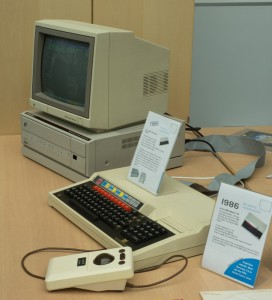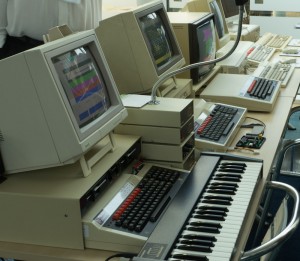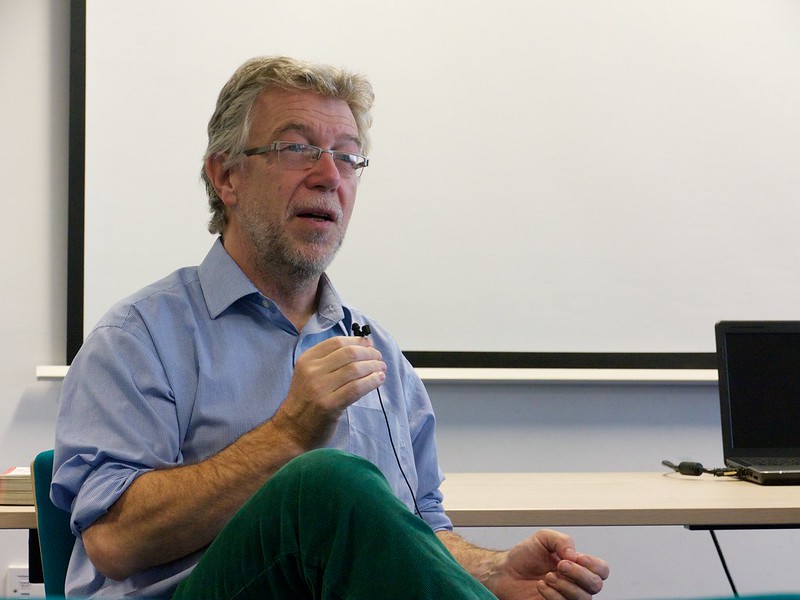More from this set here.
Category Archives: Cambridge
Reflecting
I decided to try my hand at street photography today: I normally take too many photos of trees and dogs and not enough of people.
I’ll post a few of the results over the next few days, but you can see the whole lot here if wanted.
Lots More Pots
Following on from the article mentioned yesterday, the World Service broadcast about the Trojan Room Coffee pot went out today.
Links to the programme, and a downloadable version here, if wanted.
Lots of Pots
Regular readers will know this story well by now, but there’s a piece on the BBC Technology site about the Trojan Room Coffee Pot, by Rebecca Kesby.
An audio interview with me, Paul Jardetzky and Martyn Johnson goes out on the BBC World Service tomorrow. Haven’t heard it yet…
Law in action…
Many students going to university to study Law have little idea of what it really involves, or what they should be reading to prepare for it. (Or to prepare for interviews!)
My friend Mark Elliott, who teaches in the Law Faculty here in Cambridge, has started a fabulous blog called applyingforlaw.org, which both gives some insight into what studying law is all about, and discusses some of the legal issues behind topics currently in the news.
I know this may not seem like a focal point for most Status-Q readers, but, especially if you do have friends, family, kids, nephews or nieces thinking about studying law, politics etc, or even with a general interest in it, do point them at applyingforlaw.org – it’s a great resource, and an enjoyable read.
Update – Mark has now moved his site to publiclawforweveryone.com.
Is the ‘Internet of Things’ the BBC Micro of the future?
 There was a great opportunity in Cambridge today for techies of a certain age to get all nostalgic about a machine which, for many of us, changed our lives, at the 30th anniversary party for the BBC Micro.
There was a great opportunity in Cambridge today for techies of a certain age to get all nostalgic about a machine which, for many of us, changed our lives, at the 30th anniversary party for the BBC Micro.
Organised by Jason Fitzpatrick’s soon-to-be-Cambridge-based Centre for Computing History, with the assistance of ARM, Redgate and several others, this brought together most of the original team, and many of the original machines and peripherals, that we remembered so well.
There was much discussion about the legacy of the project, and my friend Eben Upton gave an inspiring talk about the aims of the Raspberry Pi team, which many hope will be the BBC Micro for the next generation.
One thing that occurred to me during the presentations was that the original BBC Model B sold for £399, or approximately £1200 in today’s money. (That’s about the price of a MacBook Pro now.) The investment that my parents were making in my future was not the cost of a Raspberry Pi. It was the cost of about 40 Raspberry Pis – a whole classroom-full. Eben, significantly, pointed out in his talk that they hoped it wouldn’t really be schools or parents who would buy most of these. It would be the children themselves. And I think that’s important.
 Now, progress always depends on building new layers of technology on the platforms provided by the past. When I was young, the transition in play was from a world in which we bought electronic components to one in which we bought computers. Sinclair and Acorn made that transition accessible to kids. But computers are now a commodity, and you can argue that what’s really important for kids to learn is the different ways of connecting them together in the real world. So my hope is that initiatives like Raspberry Pi will allow kids not just to own a computer, but to own a network. To learn about how networks work, to invent new ways of making use of them. Yesterday’s solder track is today’s ethernet cable. Yesterday’s 6502 assembly language is today’s IPv6 routing table.
Now, progress always depends on building new layers of technology on the platforms provided by the past. When I was young, the transition in play was from a world in which we bought electronic components to one in which we bought computers. Sinclair and Acorn made that transition accessible to kids. But computers are now a commodity, and you can argue that what’s really important for kids to learn is the different ways of connecting them together in the real world. So my hope is that initiatives like Raspberry Pi will allow kids not just to own a computer, but to own a network. To learn about how networks work, to invent new ways of making use of them. Yesterday’s solder track is today’s ethernet cable. Yesterday’s 6502 assembly language is today’s IPv6 routing table.
And if we believe that there’s any mileage in the internet-of-things/automated-home ideas, then perhaps the equivalent investment that today’s parents might make could be, say, a ‘connected room’ kit, which allowed kids to give a URL to each lightbulb, each plug socket, each radiator valve, each loudspeaker, and the door. And then see how they link those together, and to their Facebook account, and to the Xbox, and so forth. Turn the music on when you turn on the light. Turn the heat down when you go to bed. Turn the lights down when you turn on the TV. It’s a Lego kit that lets you play with the living spaces of the future, and perhaps monitor your carbon footprint at the same time.
Maybe… I don’t know. There may be better ideas. This sounds fun to me, though! It could teach you a lot about networking.
And it could still cost much less than the original BBC Micro did.
Serendipity
Cambridge college dinners vary greatly, but one of the joys is their occasional unpredictability.
Tonight, for example, I sat next to the Costa Rican ambassador. She was delightful company, and we discussed our favourite scuba-diving spots…
Emotional Computing
I’ve always been fascinated by the work my friend Peter Robinson and his team have been doing at the University’s Computer Lab, in trying to make computers both understand, and express, emotions.
But I hadn’t seen this very nice little video they made just over a year ago.
Digital Archaeology: Ode to a Cantabrigian Urn
 Tucked away on a backup disk yesterday, I discovered a few thousand of my emails from the 1990s. And in the folder from late Feb 1992, I found something I thought was lost forever. Bob Metcalfe was visiting Cambridge, on sabbatical to the University Computer Lab, just as we were setting up the Trojan Room Coffee Pot camera. He wrote about it in his column in Communications Week, a publication which, sadly, closed down not long afterwards (roughly at the time when the camera was connected to the web and became quite famous). This original article was therefore, unknowingly, the first published reference to what was to become the world’s first webcam.
Tucked away on a backup disk yesterday, I discovered a few thousand of my emails from the 1990s. And in the folder from late Feb 1992, I found something I thought was lost forever. Bob Metcalfe was visiting Cambridge, on sabbatical to the University Computer Lab, just as we were setting up the Trojan Room Coffee Pot camera. He wrote about it in his column in Communications Week, a publication which, sadly, closed down not long afterwards (roughly at the time when the camera was connected to the web and became quite famous). This original article was therefore, unknowingly, the first published reference to what was to become the world’s first webcam.
But I didn’t have a copy, and nor did Bob – the old Mac floppy on which he saved it would have been hard to read now even if he could have found it – and if anyone kept an archive of CommWeek articles, I haven’t found it on the web. (Few people in 1992 would have heard of the World Wide Web, even those reading this kind of technical article.) But, as it went to press, Bob sent me a copy by email, and, sure enough, just over 20 years later, there it was, easily readable by my Apple Mail program.
There’s probably some useful lesson there about the longevity of different data formats… Anyway, while it may have little interest to anyone not closely involved with networking technologies at the time, I’m still very glad that, with Bob’s kind permission, I can now make the article available here. And I must take more care of my email archives in future…
It’s lovely once you’re in…
A rainy night at Gog Magog Hills farm shop – one of my favourite local haunts.
In a box in the loft I found my old Olympus OM30, which I purchased a little over a quarter of a century ago: an OK, but never great, camera. With it, however, were a couple of Olympus OM-series Zuiko lenses, which were pretty good for the price. And I was delighted to find that you can get adapters to connect them to a micro-4/3 body like my Panasonic Lumix GH2. You can buy the adapter from Olympus for £143 or from Fotodiox for £29. I chose the latter.
My first few experiments with the combination are here.
© Copyright Quentin Stafford-Fraser







Recent Comments